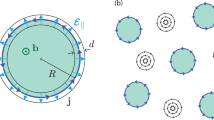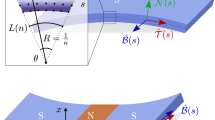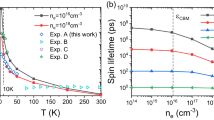Abstract
What happens to spin-polarized electrons when they enter a superconductor? Superconductors at equilibrium and at finite temperature contain both paired particles (of opposite spin) in the condensate phase as well as unpaired, spin-randomized quasiparticles. Injecting spin-polarized electrons into a superconductor (and removing pairs) thus creates both spin and charge imbalances1,2,3,4,5,6,7, which must relax when the injection stops, but not necessarily over the same time (or length) scale. These different relaxation times can be probed by creating a dynamic equilibrium between continuous injection and relaxation; this leads to constant-in-time spin and charge imbalances, which scale with their respective relaxation times and with the injection current. Whereas charge imbalances in superconductors have been studied in great detail both theoretically8 and experimentally9, spin imbalances have not received much experimental attention6,10,11 despite intriguing theoretical predictions of spin-charge separation effects12,13. Here we present evidence for an almost-chargeless spin imbalance in a mesoscopic superconductor.
This is a preview of subscription content, access via your institution
Access options
Subscribe to this journal
Receive 12 print issues and online access
$259.00 per year
only $21.58 per issue
Buy this article
- Purchase on SpringerLink
- Instant access to full article PDF
Prices may be subject to local taxes which are calculated during checkout




Similar content being viewed by others
References
Clarke, J. Experimental observation of pair-quasiparticle potential difference in nonequilibrium superconductors. Phys. Rev. Lett. 28, 1363–1366 (1972).
Tinkham, M. & Clarke, J. Theory of pair-quasiparticle potential difference in nonequilibrium superconductors. Phys. Rev. Lett. 28, 1366–1369 (1972).
Aronov, A. Spin injection and polarization of excitations and nuclei in superconductors. J. Exp. Theor. Phys. 44, 193–196 (1976).
Johnson, M. Spin coupled resistance observed in ferromagnet–superconductor–ferromagnet trilayers. Appl. Phys. Lett. 65, 1460–1462 (1994).
Takahashi, S., Imamura, H. & Maekawa, S. Spin imbalance and magnetoresistance in ferromagnet/superconductor/ferromagnet double tunnel junctions. Phys. Rev. Lett. 82, 3911–3914 (1999).
Chen, C. D., Kuo, W., Chung, D. S., Shyu, J. H. & Wu, C. S. Evidence for suppression of superconductivity by spin imbalance in Co–Al–Co single-electron transistors. Phys. Rev. Lett. 88, 047004 (2002).
Tinkham, M. Tunneling generation, relaxation, and tunneling detection of hole–electron imbalance in superconductors. Phys. Rev. B 6, 1747–1756 (1972).
Schmid, A. & Schön, G. Linearized kinetic equations and relaxation processes of a superconductor near TC . J. Low Temp. Phys. 20, 207–227 (1975).
Clarke, J. in Nonequilibrium Superconductivity, Phonons, and Kapitza Boundaries (ed. Grey, K. E.) 353–422 (NATO Science Series B, Vol. 65, Springer, 1981).
Leridon, B., Lesueur, J. & Aprili, M. Spin-bottleneck due to spin-charge separation in a superconductor. Phys. Rev. B 72, 180505 (2005).
Cadden-Zimansky, P., Jiang, Z. & Chandrasekhar, V. Charge imbalance, crossed Andreev reflection and elastic co-tunnelling in ferromagnet/superconductor/normal-metal structures. New J. Phys. 9, 116 (2007).
Kivelson, S. A. & Rokhsar, D. S. Bogoliubov quasiparticles, spinons, and spin-charge decoupling in superconductors. Phys. Rev. B 41, 11693–11696 (1990).
Zhao, H. L. & Hershfield, S. Tunneling, relaxation of spin-polarized quasiparticles, and spin-charge separation in superconductors. Phys. Rev. B 52, 3632–3638 (1995).
Tinkham, M. Introduction to Superconductivity 2nd edn (Dover, 2004).
Chiodi, F., Aprili, M. & Reulet, B. Evidence for two time scales in long SNS junctions. Phys. Rev. Lett. 103, 177002 (2009).
Jedema, F. J., Heersche, H. B., Filip, A. T., Baselmans, J. J. A. & van Wees, B. J. Electrical detection of spin precession in a metallic mesoscopic spin valve. Nature 416, 713–716 (2002).
Johnson, M. & Silsbee, R. H. Spin-injection experiment. Phys. Rev. B 37, 5326–5335 (1988).
Valenzuela, S. O. & Tinkham, M. Spin-polarized tunneling in room-temperature mesoscopic spin valves. Appl. Phys. Lett. 85, 5914–5916 (2004).
Münzenberg, M. & Moodera, J. S. Superconductor-ferromagnet tunneling measurements indicate sp-spin and d-spin currents. Phys. Rev. B 70, 060402 (2004).
Alvarado, S. F. Tunneling potential barrier dependence of electron spin polarization. Phys. Rev. Lett. 75, 513–516 (1995).
Tedrow, P. M. & Meservey, R. Spin polarization of electrons tunneling from films of Fe, Co, Ni, and Gd. Phys. Rev. B 7, 318–326 (1973).
Meservey, R. & Tedrow, P. Spin-polarized electron tunneling. Phys. Rep. 238, 173–243 (1994).
Fulde, P. High field superconductivity in thin films. Adv. Phys. 22, 667–719 (1973).
Anthore, A., Pothier, H. & Esteve, D. Density of states in a superconductor carrying a supercurrent. Phys. Rev. Lett. 90, 127001 (2003).
Poli, N. et al. Spin injection and relaxation in a mesoscopic superconductor. Phys. Rev. Lett. 100, 136601 (2008).
Huertas-Hernando, D., Nazarov, Y. V. & Belzig, W. Absolute spin-valve effect with superconducting proximity structures. Phys. Rev. Lett. 88, 047003 (2002).
Bergmann, G., Lu, J. & Wang, D. Meservey-Tedrow effect in ferromagnet/superconductor/ferromagnet double tunnel junctions. Phys. Rev. B 71, 134521 (2005).
Pierre, F. et al. Dephasing of electrons in mesoscopic metal wires. Phys. Rev. B 68, 085413 (2003).
Lemberger, T. R. One-to-one correspondence of charge-imbalance relaxing mechanisms with pair-breaking mechanisms in superconductors. Phys. Rev. B 29, 4946–4950 (1984).
Hübler, F., Lemyre, J. C., Beckmann, D. & v Löhneysen, H. Charge imbalance in superconductors in the low-temperature limit. Phys. Rev. B 81, 184524 (2010).
Kleine, A. et al. Magnetic field and contact resistance dependence of non-local charge imbalance. Nanotechnology 21, 274002 (2010).
Yang, H., Yang, S., Takahashi, S., Maekawa, S. & Parkin, S. S. P. Extremely long quasiparticle spin lifetimes in superconducting aluminium using MgO tunnel spin injectors. Nature Mater. 9, 586–593 (2010).
Yafet, Y. Conduction electron spin relaxation in the superconducting state. Phys. Lett. A 98, 287–290 (1983).
Hübler, F., Wolf, M. J., Beckmann, D. & v. Löhneysen, H. Long-range spin-polarized quasiparticle transport in mesoscopic Al superconductors with a Zeeman splitting. Phys. Rev. Lett. 109, 207001 (2012).
Acknowledgements
We thank C. Strunk, B. Reulet, J. Gabelli, B. Leridon, Y. Nazarov, D. Beckmann and J. Lesueur for discussions on spin injection; S. Rohart for advice on magnetic materials; S. Autier-Laurent for technical assistance; and S. Guéron, J. Gabelli and R. W. Ogburn for comments on the manuscript. This work was funded by a European Research Council Starting Independent Researcher Grant (NANO-GRAPHENE 256965), a C’NANO grant (DYNAH) from the Ile-de-France region and an ANR Blanc grant (DYCOSMA) from the French Agence Nationale de Recherche.
Author information
Authors and Affiliations
Contributions
C.Q.H.L. and M.A. fabricated the samples and performed the measurements. All the authors contributed to the data analysis and the writing of the manuscript.
Corresponding author
Ethics declarations
Competing interests
The authors declare no competing financial interests.
Supplementary information
Supplementary Information
Supplementary Information (PDF 1214 kb)
Rights and permissions
About this article
Cite this article
Quay, C., Chevallier, D., Bena, C. et al. Spin imbalance and spin-charge separation in a mesoscopic superconductor. Nature Phys 9, 84–88 (2013). https://doi.org/10.1038/nphys2518
Received:
Accepted:
Published:
Issue date:
DOI: https://doi.org/10.1038/nphys2518
This article is cited by
-
Tunable spin injection and detection across a van der Waals interface
Nature Materials (2022)
-
Evidence for spin-dependent energy transport in a superconductor
Nature Communications (2020)
-
Controlling spin supercurrents via nonequilibrium spin injection
Scientific Reports (2019)
-
Flux flow spin Hall effect in type-II superconductors with spin-splitting field
Scientific Reports (2019)
-
Enhanced spin pumping into superconductors provides evidence for superconducting pure spin currents
Nature Materials (2018)



